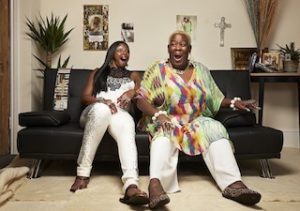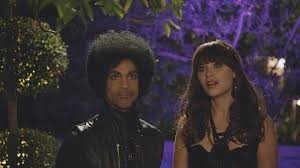Pt. II: The Making and Casting of Gogglebox
*This interview was edited for clarity. It was conducted via phone with e-mail followups.
Did you have previous influences when you were creating the series?
The best way to have described the idea to someone at the point of inception was to imagine the visuals and tone of The Royle Family, the hugely successful BBC sitcom that focuses on a northern working class family who sit around all day watching television and discussing the latest goings on in their lives, and blend this with the wit and tonality of Harry Hill’s TV Burp, a clever and funny scripted commentary of some of the week’s television delivered by Harry Hill with clips to illustrate.

Photo Courtesy ITV Open Archives.
But what we would add was real people delivering the humour and insight from their very own sofas, in their very own homes as they watched the week’s telly and breaking news stories. It was hugely important to us that it was topical. We were going to the trouble of making it incredibly quickly so it had to be totally up to the minute. I’ve always believed that it’s real people who say the funniest things, things that even the best comedy scriptwriters could only dream of coming up with. Our cast has been so unbelievably funny at times that people have refused to believe it’s not scripted. It’s categorically not scripted and I think that the cast would take great umbrage in anyone suggesting they aren’t as witty naturally as they clearly are.
I think people can be very funny, and funny when they don’t know they’re being funny. That works best for Gogglebox. The cast that don’t realise they are funny are the best for us. For Gogglebox I visualised the Royle Family set up, it was the first thing that came to mind; a huge influence and inspiration and that’s why Caroline Aherne (writer of and actor in The Royle Family) was the perfect choice for the Gogglebox narrator – she’s got that really gossipy warm northern tone that I love.
What goes on in the labor of producing an episode of Gogglebox?
We film with five households around Britain each night. Each households is filmed by a small crew comprising a producer, a camera operator, a soundie, and a logger / researcher. There are just two cameras rigged in each house – one locked off on the wide and one tracking the close-up. I designed it specifically to be like this. It was set so the wide angle is all you’re going to see of the families’ lives, not a millimetre more. From each of these wide ‘portraits’ you’re meant to be able to get everything you need to tell you a little of who these people are. The wide shot is predominantly used and once we visit a home we rarely edit the material. The close up camera is mainly used for comedy punctuation at the end of the dialogue – an eye role from an exasperated partner for example. Often great scripted comedies are constructed like this; it’s not what the character is saying that’s necessarily the funny thing, it’s the reaction from the other character to what they are saying that provides the laugh out loud moment. That was my intention. I also like staying with the wide because I’m just as interested in seeing what one member of the family is doing when the other is speaking. It’s often dynamically revealing.
We shoot about 200 hours of material each week and use probably less than 1% of what we shoot. There’s a lot of material to trawl through but we look at every second to ensure the best material is included.
https://youtube.com/watch?v=HO-CLw78MzA
What is a week like for cutting Gogglebox?
Essentially we edit Gogglebox in around 60 hours. Working backwards from when it airs on Friday night at 9pm, we lay the finished programme to tape mid-afternoon that day; we record the voiceover that morning and I sign off the sound mix and final pictures around noon. The previous day (Thursday) the programme must be completed to show the broadcaster at noon. We spend a couple of hours after the viewing with the broadcast exec trimming and adjusting commentary. We don’t have time to do too much to it as need it locked by early Thursday evening. The programme is essentially built between Monday afternoon and Wednesday – we often work through the night on a Wednesday. We spend the first few days (Saturday and Sunday) assessing the quality of the material to make the necessary adjustments in the field.
We rely heavily on a great cast. If the cast can’t deliver in a fast and immediate way we would struggle to make this each week.
What are the technicalities of the cameras being used?
It’s a simple rig, takes about 90 minutes to rig each house and as I said it’s just two cameras, Sony 900 hotheads, in each home. We film with each of the five families up to eight hours per night. We film roughly four programmes and a couple of news stories each night. In between each programme we film preamble, those little documentary moments you see between the packages. Everyone asks how produced it is and the simple answer is it’s not – the cast don’t react well to being questioned or prompted. Usually the crew sets up a mini gallery in a side room, a bedroom or kitchen. The producer can monitor the material and direct the camera op as well as communicate to the family should they choose to via a small speaker system. However, on the whole the households are left to themselves. I think the reason we get such good natural material is due to the fact that after a short while they forget the cameras and crew are there.

Photo via The Culture Mag

People also often ask me how the cast, after five seasons, remain so natural and apart from having a lot of material to choose from, I think it’s down to the fact they trust us and are just comfortable. Trust is vital when you are working with everyday people. I think that the wonderful honesty of our cast is due in part to the bond of trust we have developed with them – they know we only want to show them in the best light so they don’t try and censor or produce themselves.
What’s very apparent is how down to earth they all are still. I went and met everyone in their homes with the BAFTA – they all wanted to take selfies with it. It struck me how similar everyone is to their on screen self. Sandy and Sandra are just as gregarious and energetic in person. No one is quieter no one is louder, they’re exactly how they come across on TV.
One of our major challenges is to keep the content rich week in week out. We arrive at these people’s homes to start filming around 7 PM and some people may have had a tough day at work, others may have money worries or relationship issues. We are impacting each week on these people’s everyday lives, we turn up with all our gear and it’s ‘okay right, we’re going to show you some telly! and hopefully you’ll be hilarious, even if you don’t feel like being funny or energised we still need you to put your worries and concerns aside and just be brilliantly entertaining. It’s incredibly hard and you certainly cannot rely on it being pitch perfect every time. Each week we face never knowing what we will get and whether it will be good. It’s a scary prospect but somehow we pull it out the bag.
We’ve done our best to look after the cast. I’m not interested in putting dirt out there. It’s not what Gogglebox is about so they trust us, they trust us implicitly. The production division of my team are amazing and have a strong support structure in place for the cast.
And how did you cast the show? I’ve read it was a very unconventional way, very anti-reality TV.
There’s never been an application process for Gogglebox. If you ask me what are the types of people I’m looking for, I’d say that I don’t want people that want to be on telly. I especially don’t want people that want to be on Gogglebox. Most of our cast have had to be persuaded to do it. June didn’t want to do it. Linda and Pete didn’t think they were funny and were amazed that we wanted them. Those people who don’t think they’re funny are usually very funny and their lack of awareness is attractive. If someone says they’d be great on Gogglebox you can guarantee they probably won’t be. We didn’t want loads of wannabes so I said no to applications and we will street cast.
What was the alternative way to find the cast?
I sent the team out to pubs, high streets, shopping centers, just told them to approach interesting looking people. We found Sandy and Sandra, the two ladies from Brixton. in a pub drinking in the afternoon. Like with all the cast when we get a sense they might be good we do ‘silent auditions.’

We hold up pictures of politicians, celebrities, newspaper headlines, logos of TV shows and presenters any strong and provocative cultural reference points. We hold these images up and then watched as the families start to debate what they are seeing. Very quickly it allows us to gauge how speedy and smart their responses were, how interesting was what they were saying and the levels of that interest. Also it quickly highlighted the dynamics within a family, who had the loudest voice, who tended to shout the other one down etc. So pretty quickly we got a sense of their humour, how interesting they were and their politics. We left the cards up sometimes longer than was comfortable and that’s when we got the best stuff. To be honest if they passed that rigorous session they stood a good chance of going through to the next stage which was watching some actual TV shows.
Next week: The third and final installment of the Gogglebox interview, in which Alexander discusses the distinct British-ness of the series, its critical reception, and the rising popularity of its cast.
Stefania Marghitu is a PhD student at the University of Southern California School of Cinematic Arts’ Division of Critical Studies. Her primary interests deal with critical and cultural studies of television, the showrunner and modes of authorship, feminist TV criticism and production studies. You can find her work published in The Spectator’s Performing Labor in the Media Industries issue (forthcoming in Fall 2015), Gender Forum, Flow TV, and the edited collections Refocus on Amy Heckerling (Edinburgh University Press, forthcoming in 2016) and Smart Chicks on Screen: Representing Women’s Intellect in Film and Television (2014).





